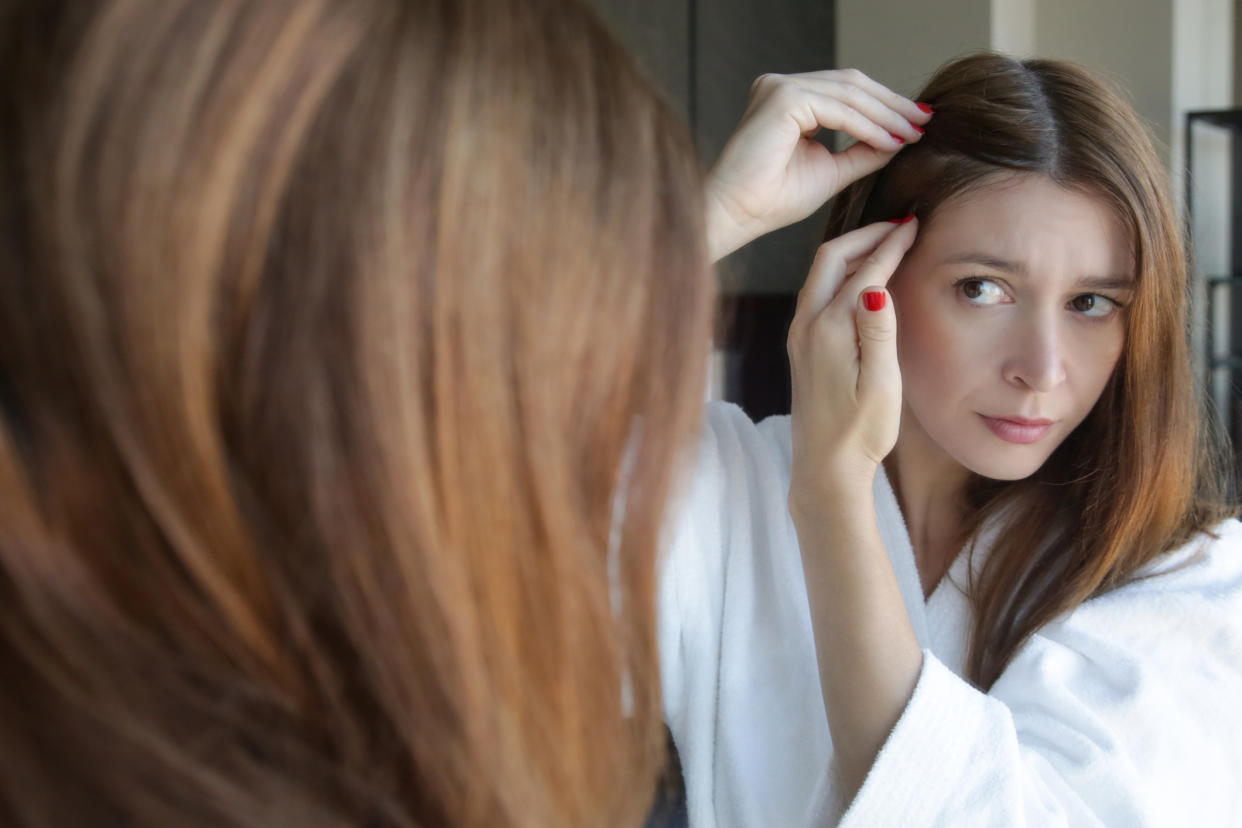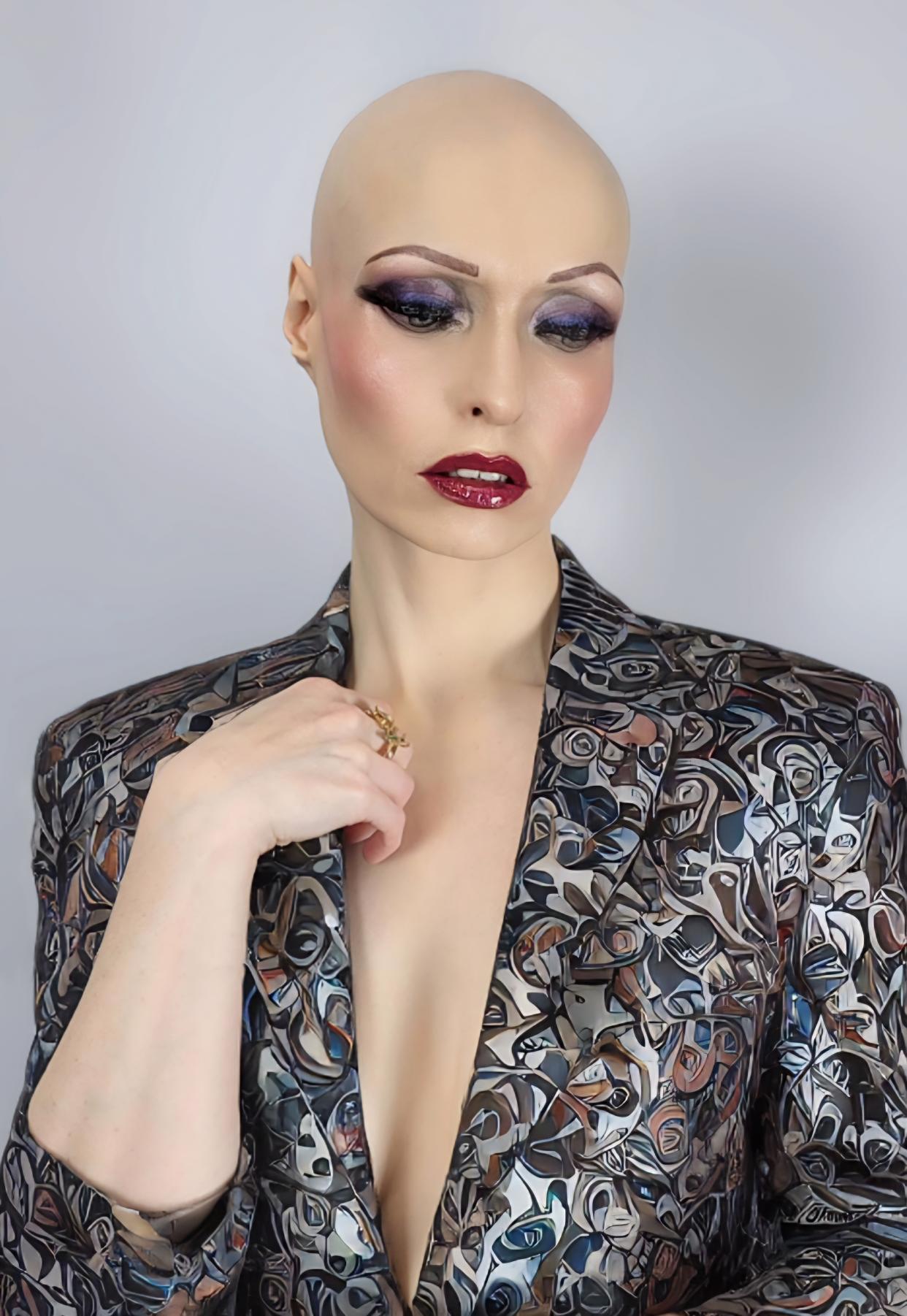Signs and symptoms of the hidden hair loss condition FFA

Experts have warned about a rise in the number of people experiencing a somewhat hidden hair loss condition, which can cause sufferers to lose hair from their eyebrows.
September marks alopecia awareness month, and whilst alopecia areata is the most widely discussed form of the condition, the number of people experiencing frontal fibrosing alopecia (FFA) has increased in recent years.
This form of alopecia sees people lose hair from their face, eyebrows and across their hairline, with a recent study, by the National Library of Medicine, revealing that 96% of people with this particular type of the condition experience hair loss from their eyebrows.
Interestingly, FFA most commonly affects women after they go through menopause but this does not mean that younger women and men, do not experience the condition as well.
Louis Theroux recently debuted his new eyebrows after turning to semi-permanent make-up to combat a form of alopecia.
The 53-year-old investigative documentary presenter revealed in 2023 that he had lost his famous eyebrows after developing the auto-immune condition.
What is frontal fibrosing alopecia (FFA)?
According to the British Association of Dermatologists FFA is a form of scarring hair loss affecting the hair margin on the front of the scalp.
This happens due to inflammation and destruction of the hair follicles. There may also be hair loss from the scalp near the ears and from the eyebrows.
As well as women who have gone through the menopause there are some other factors, which can make someone more likely to experience frontal fibrosis alopecia, with it being more common in: those who:
Those that have rosacea
Those who have a thyroid disease like hypothyroidism
Those who are related to someone with FFA
Those who suffer from Type 2 diabetes
Symptoms of FFA
In FFA, hair loss and scarring make the hairline recede, across the forehead and sideburns of the scalp. The skin of the scalp that is affected often looks normal, but it can look pale or shiny and no hair follicles can be seen.
According to Dr Baliw, hair surgeon at Elithair the main symptom of FFA is hair loss around the front and sides of the hairline, including eyelashes and eyebrows.
This hair loss can start slowly but worsen over time, signs to look out for on the skin include:
Pale, shiny skin
Hyperpigmentation, dark brown or grey areas of the skin, face and neck
Itchy skin: Before noticeable hair loss, people with FFA can experience itching or discomfort to the skin on their scalp.
Small yellow or skin-coloured lumps near the hairline: Some people will develop a rash on their hairline before the hair loss when suffering from FFA
Hair loss from several areas of the body (e.g. beards, arms, legs etc..)
"Frontal Fibrosing Alopecia will usually begin with a receding hairline starting along the temples or front of the hairline, but some people will notice hair loss and thinning around the edges of their eyebrows first," Dr Baliw adds.

What are the suspected causes of FFA?
The exact cause of frontal fibrosing alopecia is still unknown and will differ from person to person, but Dr Baliw says there are several suspected causes of FFA.
Autoimmune disease
FFA may occur if the immune system attacks the hair follicles, preventing hair growth.
"People with autoimmune diseases like lupus erythematosus, Crohn's disease and rheumatoid arthritis may be more likely to develop FFA," Dr Baliw explains.
Hormones
Most women who experience FFA are postmenopausal, in fact, the National Institute of Health suggests between 60-95% of women suffering from FFA have reached menopause at the point that they begin showing signs of hair loss.
"FFA is more likely to develop when oestrogen levels are low, hence why it is more common amongst women who have reached menopause," Dr Baliw adds.
Genetics
It is yet to be confirmed whether FFA is a hereditary disorder, however, many people who suffer from frontal fibrosing alopecia reported having family members with the same condition. Therefore there is a chance that FFA may have genetic links.
Environmental factors
Research suggests that if one has a genetic predisposition to FFA then it can be triggered by environmental factors such as face creams, sun exposure, infections from viruses or medications.
Individuals who are prone to contact allergies and tend to be allergic to makeup, creams and hair dye, may experience FFA as a result.
Stress
Stress can trigger FFA in people who are already at risk of developing this form of alopecia.
"This is because when the body experiences stress it prioritises sending nutrients to vital functions like organs, as opposed to less vital functions like hair growth," Dr Baliw explains. "Over time, this lack of nutrients can result in hair breakage and hair loss."
Treatment
Dr Baliw says there are various medical treatments for FFA, including:
Antibiotics to reduce inflammation: Doxycycline and Minocycline
Hair loss medications: Finasteride or Dutasteride will help prevent further hair loss
Corticosteroid creams and injections to help with hair loss
If you want a more permanent solution, hair transplants to the affected areas are also an option, including an eyebrow hair transplant.
Here, follicles are inserted from the back of your head into your eyebrows where the patient has experienced hair loss. The hairs are implanted in the precise direction of hair growth for a natural look.
"An eyebrow transplant is the only permanent solution to restore hair growth for those suffering from FFA," Dr Baliw explains. "It is a one-off procedure that, unlike methods such as microblading or eyebrow tinting, gives a natural texture and dimension."
'How I learnt to embrace my hair loss'

Brenda Finn, Ambassador for Changing Faces, a charity supporting people with a visible difference, developed alopecia universalis when she was just 14 years old. While it is a different type of alopecia to FFA, a person with alopecia universalis loses all their hair, including eyebrows and eyelashes, facial hair and body hair. Here she tells Yahoo UK how she learnt to embrace her hair loss and regained her confidence.
“Throughout my teenage years I experienced relentless bullying as a result of my hair loss and became very isolated and lonely. I tried to cover up my condition with wigs, but this didn’t stop the bullying. In the end, I decided to be home-schooled. I felt as if I had no control over anything. I couldn’t find a way to deal with people’s reactions or my own feelings and in the end I became agoraphobic.
“As an adult, working with children became my solace. They were so accepting of my differences, and I discovered a passion for performing, eventually becoming a children’s entertainer. I loved my work, but some days were harder than others. Fake it until you make it became a way of life for me. My confidence fluctuated and people’s thoughtless stares and comments could bring me right back to square one.
“Now I’ve chosen to embrace my uniqueness and I feel happier in myself than ever before. Working with my hair loss rather than hiding away from it has helped me to accept my condition and develop genuine confidence, rather than having to put on a brave face. Society constructs concepts and rules around beauty, but that’s all it is. Real beauty is something we define ourselves.
“Don’t be afraid to challenge outdated norms. You are in control of how you view yourself, so don’t let outside sources bring you down.”
Read more about hair loss
Doctor debunks five most common hair loss myths (Yahoo Life UK, 5-min read)
One in 10 men worried their hairline will end their relationship (Yahoo Life UK, 5-min read)
Can heartbreak lead to hair loss? (Yahoo Life UK, 4-min read)


